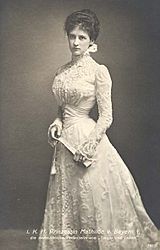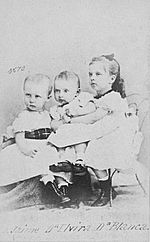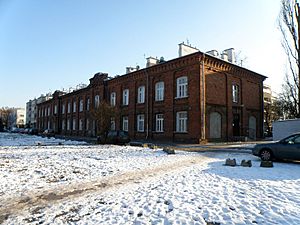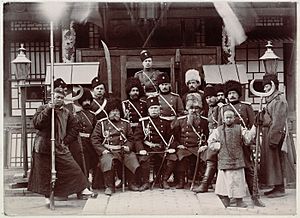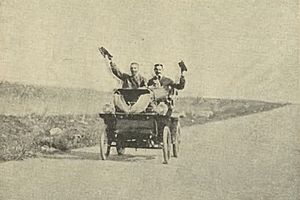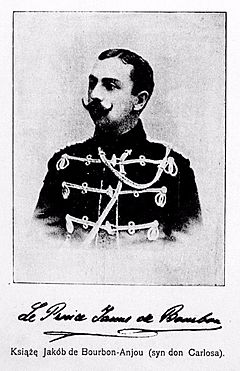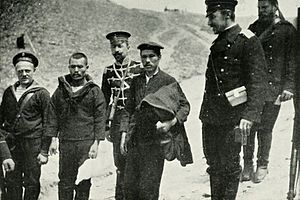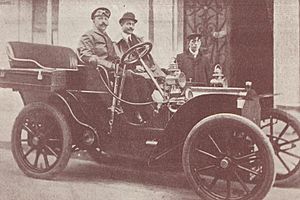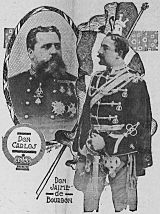Infante Jaime, Duke of Madrid facts for kids
Quick facts for kids Jaime de Borbón |
|||||
|---|---|---|---|---|---|
| Duke of Madrid and of Anjou | |||||
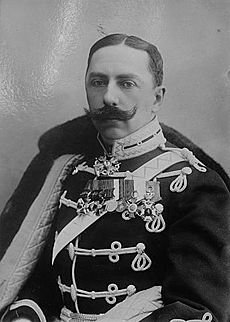
Jaime de Borbón, 1911
|
|||||
| Carlist pretender to the Spanish throne as Jaime III |
|||||
| Pretendence | 18 July 1909 – 2 October 1931 | ||||
| Predecessor | Carlos VII | ||||
| Successor | Alfonso Carlos I | ||||
| Legitimist pretender to the French throne as Jacques I |
|||||
| Pretendence | 18 July 1909 – 2 October 1931 | ||||
| Predecessor | Charles XI | ||||
| Successor | Charles XII | ||||
| Born | 7 June 1870 Vevey, Switzerland |
||||
| Died | 2 October 1931 (aged 61) Paris, France |
||||
|
|||||
| House | Bourbon | ||||
| Father | Infante Carlos, Duke of Madrid | ||||
| Mother | Princess Margherita of Bourbon-Parma | ||||
| Religion | Roman Catholic | ||||
| Royal styles of Jaime de Borbón |
|
|---|---|
 |
|
| Reference style | His Royal Highness |
| Spoken style | Your Royal Highness |
| Alternative style | Sir |
Jaime de Borbón y de Borbón-Parma (born June 27, 1870 – died October 2, 1931) was a very important person in two royal families. He was known as the Duke of Madrid in Spain and Jacques de Bourbon, Duke of Anjou in France. He was a claimant to the throne of Spain as Jaime III for the Carlist movement. He was also a claimant to the throne of France as Jacques I for the Legitimist group.
Contents
Family Life
Jaime de Borbón never married and did not have any children.
His Parents
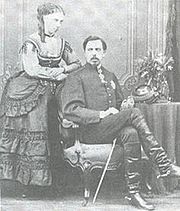
Jaime's father was Carlos de Borbón (1848–1909). He was known as Carlos VII and was a claimant to the Spanish throne. He was also a claimant to the French throne as Charles XI. Jaime's mother was Marguerite de Bourbon-Parme (1847–1893). She was the daughter of a duke from Parma. After his mother died, Jaime's father married Berthe de Rohan in 1894, but they had no children.
Marriage Rumors
Throughout his life, there were many rumors about who Jaime might marry. When he was 15, people thought he might marry Mercedes, the daughter of King Alfonso XII of Spain. Later, when he was 26, he exchanged friendly letters with Princess Mathilde of Bavaria. However, their relationship did not last.
As he got older, more rumors appeared. He was linked to several princesses and noblewomen. He was even interested in his cousin, Marie-Antoinette de Bourbon-Parme, and later her older sister, Zita. Despite these many rumors and his own efforts, Jaime de Borbón never found a wife.
Growing Up
Jaime's childhood was spent moving between different places and often away from his parents. He grew up in a very international environment, learning French, Spanish, German, English, and Italian.
Early Years
Jaime's birth was a big event for the Carlist supporters, who saw him as a future king of Spain. He lived with his parents and older sister in Switzerland and then in Geneva. In 1873, his mother moved with the children to Pau, France. His father, Carlos VII, was in Spain leading troops during the Third Carlist War. In 1874, young Jaime visited his father in Spain and was cheered by soldiers.
Later, his family moved to Paris. In 1877, Jaime started attending a famous Jesuit school called Collège de l'Immaculée-Conception. He lived at the school with other students from 1880, after his father had to leave France and moved to Venice.
Teenage Years
In 1881, Jaime went to Beaumont College, another well-known Jesuit school near London. This school was for Catholic noble families from all over Europe. Jaime was treated specially as an important student. He spent holidays in Italy with his parents. He finished school in 1886.
That same year, he inherited some land and a palace called Schloss Frohsdorf in Austria. He had serious health problems in 1887 and traveled to Egypt and Palestine to recover. In 1888, he went on his first diplomatic trip to the Vatican. He also traveled across Europe in 1889, attending his sister's wedding and visiting museums.
Becoming an Adult
In 1890, Jaime began his military education at the Theresian Military Academy in Austria. He graduated in 1893. However, because of political disagreements between his father and the Austrian emperor, Jaime was not allowed to join the Austrian army.
From 1894 to 1895, he traveled a lot, visiting places like India, Thailand, Indonesia, and the Philippines. In 1894, he visited Spain for the first time since he was a small child. He traveled secretly, but people often recognized him. His journey was widely talked about in the newspapers.
Around the mid-1890s, his father tried to find a place for Jaime in another European army. Eventually, in 1895, it was decided that Jaime would join the Russian army.
Time in Warsaw
Jaime de Borbón served in the Russian army in Warsaw for almost six years, from 1898 to 1903, though he was often away. This period was important for his development.
Military Service
Jaime joined a cavalry unit in Odessa in 1896 before moving to Warsaw in 1898. He was assigned to a very respected cavalry regiment, the Life Guard Grodno Hussar Regiment. When he arrived, he was likely an ensign. He was promoted to lieutenant in 1900, and later to captain in 1904, and finally to colonel. We don't know much about his daily duties in the regiment. In 1903, he was transferred to the personal staff of the Warsaw district commander.
Time Away
Jaime's time in Warsaw was not continuous. He spent about 40 months in the city in total. He usually left around November because of the cold weather and returned in April. His longest stay was from November 1899 to June 1900.
When he was away, he was either on leave in Europe or on military assignments. He served on a border commission near Turkey, Afghanistan, and Persia in 1899. He also fought in the Boxer Uprising in China from 1900 to 1901 and in the Russo-Japanese War starting in 1904.
Fighting in China
When the Boxer Rebellion started in China, Jaime asked Tsar Nicholas II for permission to join the Russian troops. The Tsar agreed. In August 1900, Jaime traveled to Port Arthur and joined a Russian group. He was part of General Konstantin Tserpitsky's troops, who moved into northeastern China.
One important event was when Jaime reportedly led a successful mission to help a Belgian-Dutch Catholic mission that was surrounded by the Boxers. He later got special permission from the Tsar to keep troops in that area. In December, he got sick with typhus and was sent to a hospital in Japan. He then sailed to France in February 1901. For his actions, he received the Order of Leopold from Belgium.
Life in Warsaw
At first, Jaime lived in a simple one-room apartment in the military barracks. Later, he moved to a nicer apartment in a fancy part of Warsaw. Even though he was not a high-ranking officer, he attended important official events with members of the royal family and top generals.
Jaime was not very involved in the local community, but he enjoyed theaters and restaurants. He was well-known as a sportsman, especially for his love of cars. He owned one of the first cars in Warsaw, a De Dion Bouton, which was easily recognized by people in the city. He was often seen driving with Stanisław Grodzki, a local car pioneer.
Politics in Warsaw
Newspapers in Warsaw reported on events in Spain, but they rarely connected these reports to Jaime. They usually referred to him as "His Royal Highness" and were polite. There was no strong support or opposition for the Carlist cause in the local press. Jaime did not get involved in political activities in Warsaw. He left the city before major unrest started in 1905.
Looking Back at Warsaw
Jaime joined the Russian army in his mid-20s. His time in Warsaw and his military service in the Far East were important experiences for him. However, his service in the Russian army is not widely known in history books about Spain or Poland. Historians usually focus on his later role in Spanish politics.
Middle Age: The Eternal Traveler
After leaving Warsaw in late 1903 and before becoming a claimant to the throne in 1909, Jaime was in his middle age. He served in the Russo-Japanese War for about seven months in 1904, then moved to Paris. From 1906, he visited Spain often, but he did not openly get involved in politics. He was building connections and learning about the country.
Russo-Japanese War
In early 1904, while on leave in Venice, Jaime was called back to duty for the Russo-Japanese War. He traveled to the Far East and joined General Kuropatkin's staff in Port Arthur in May 1904. He was promoted to captain. He was injured after falling from a horse. He then joined the 6th Cavalry Regiment and fought in the Battle of Te-li-Ssu in June, which was a very intense experience.
He spent the next few weeks on special missions, including scouting behind enemy lines. He almost got captured by the Japanese but pretended to be an English reporter to escape. In August, he took leave in Vladivostok, but returned to duty in Mukden. In October, he was injured again after falling from a horse. In November, he received the Order of Saint Vladimir and was promoted to major. In December 1904, he left for Europe, arriving in Marseille in May 1905.
Constant Journeys
After the war, Jaime made his home in Paris. From there, he took many trips between 1905 and 1909, earning him the nickname "eternal traveler" in the Spanish press. He traveled across France and visited Rome, where he met the Pope.
In the spring of 1906, he visited Spain for the first time in 12 years. He made at least 12 more trips to Spain, usually in spring or summer, returning to Paris in the autumn. He often visited Barcelona and the Basque-Navarre region. He also visited Madrid, Avila, Zamora, Lugo, and Seville.
Jaime usually traveled by car, often trying to remain unnoticed. News of his trips would often leak to the press, leading to many rumors. He spent most of his time in Spain enjoying leisure activities like sightseeing, theaters, restaurants, and bullfights. However, he also met with local Carlist leaders privately. Sometimes, he attended larger Carlist gatherings, like in Zumarraga in 1908, but he would return to France the same day to avoid trouble with the government.
Political Views
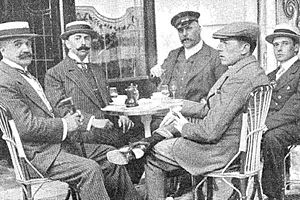
Between 1905 and 1909, Jaime did not openly participate in politics, but he was often discussed. An interview he gave in China, where he seemed to support the French government and a "republican monarchy," angered his father. He later clarified his statements. After a battle, he said he would never accept such a high price to become king, which surprised many Carlists.
He wrote a letter protesting an attack on King Alfonso XIII and his wife in 1906, calling himself a "loyal opponent." There were constant rumors that he was getting closer to the royal family or that he might even recognize Alfonso XIII as king.
When in Spain, Jaime met with regional Carlist leaders. He generally kept his public statements vague. In 1908, he gave another interview where he said Carlism was a party of order ready to help Spain. He also supported a Catalan political group and spoke in favor of Germany as an ally.
Family Relationships
Jaime's relationship with his father worsened after his father married Berthe de Rohan. Jaime and his stepmother, who were only two years apart in age, did not get along. This was one reason Jaime avoided his father's home in Venice.
His father was also angry about Jaime's interviews, which showed different political views from his own. Carlos VII was upset that Jaime was becoming more independent and did not ask for permission for his travels, especially to Spain. He felt Jaime's visits to Spain were causing problems for the Carlist movement.
Jaime had good relationships with his uncle, Don Alfonso Carlos, and his oldest sister. However, his uncle thought Jaime was a bit of a playboy who gambled away some of his money.
New Interests
As he approached 40, Jaime was aware of his unusual position as a bachelor with an unpredictable military career. He seemed unsure of his future path. He was released from the Russian army reserve in 1906 but was promoted to colonel in 1908, which some people made fun of. He often appeared in public in his Russian colonel's uniform.
Besides politics and his personal life, Jaime also became interested in new technologies. He remained a passionate car enthusiast. He also supported the development of seaplanes and invested in new ideas for boat engines, hoping to make them much faster. However, none of these projects became successful.
Claimant to Thrones

On July 18, 1909, Jaime's father died, and Jaime became the Carlist claimant to the Spanish throne, known as Jaime III. He also became the Legitimist claimant to the French throne, known as Jacques I.
Jaime left the Russian army and mostly lived at Schloss Frohsdorf in Austria and in his apartment in Paris. He visited Spain many times secretly. He also owned a villa in Italy that he inherited from his mother.
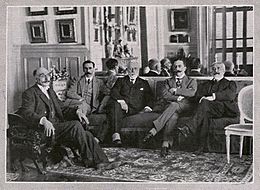
During part of World War I, Jaime was under house arrest at his palace in Austria.
In 1923, Jaime created the Order of Prohibited Legitimacy. This award honored people who were imprisoned or exiled in Spain because they supported the Carlist cause.
In April 1931, King Alfonso XIII was forced to leave Spain, and the Second Spanish Republic was declared. Jaime issued a statement asking all monarchists to support his claim. A few months later, in September, Jaime met with Alfonso XIII in Paris. They met again two days later. These meetings showed that the two claimants to the Spanish throne were becoming friendlier. Some historians believe they made an agreement called the Pact of Territet to end their disagreement, but others disagree.
A week after meeting Alfonso, Jaime died in Paris. He was buried at his villa in Italy. His uncle, Alfonso Carlos, Duke of San Jaime, took over his claims to the Spanish and French thrones.
Images for kids
See also
 In Spanish: Jaime de Borbón y Borbón-Parma para niños
In Spanish: Jaime de Borbón y Borbón-Parma para niños


